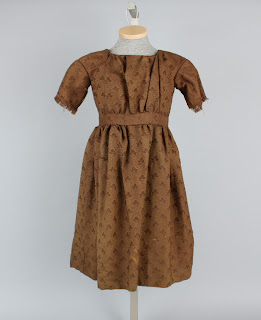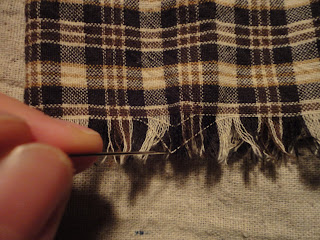Since this is meant to be for a child between the ages of 3-6, I wanted something that buttoned up the back, had clean lines with little ornamentation and wouldn't look bizarre when rendered in the slubby glory of H*bby L*bby "homespun." (Homespun my ass...) I really liked this fabric. It was a pretty combination of green, brown and cream with a jaunty yellow stripe thrown in for fun. I based the garment off of this dress from the Wisconsin Historical Society website:
This is advertised as an 1849 silk gown intended for a 4 year old girl. How perfect is that? And it was a relief to find something simple. This, for all its silk textile, is a very, lets say... "casually constructed" dress. And since I am at best a "casual" seamstress, this fit the bill. I like that the dress makes use of the native elements of the fabric in design and pattern for detail rather than additional embellishment. Onward with the sewing!
I made this dress like I made pretty much all of the children's clothing items. It started life as a series of rectangles and squares that were gathered and shaped accordingly as I went. I was able to find a study citing the average heights of slaves in the United States during the early 19th century, but it unfortunately starts at age 8. (Though that TOTALLY came in handy for C.) So I used a combination of witchcraft, sorcery and guesswork to determine what size to make this. The fact its meant to represent a child from a fairly broad range of age helped immensely. Instead of gently gathering the fashion fabric as seen on the original, I just laid the plaid fabric on the bias. It offers a subtle nod to the ubiquitous 1840's fan-front style.
I don't have a picture from the "squares" phase of construction. Consider yourselves spared. Here's the inside-out shot of the top of the bodice:
The dress is lined with osnaburg. I really wanted to use materials that were as authentic as possible. Jehossee was an atypical Southern plantation in a multitude of ways, so while no full outer garments are made of the stuff, it is used for the "unseen" aspects of garb. You can see my crooked little stitches. I was attaching the sleeve to the armscye here. You can also make out the piping on the neckline.
My weird little arm treatment. Is this a "thing?" I have no idea. I haven't seen very many surviving garments from the 1840-50s. This treatment reinforces the armscye and due to the flimsy nature of the outer fabric and the loose weave of the inner fabric, this was a big plus. It also creates a smooth transition between the inner bodice and the sleeve. In other garments that I worked on, this was an issue. The finishing was sloppy or non-existent and while I can't speak to the historical accuracy of everything I've done, I do try to consider first and foremost the practicality of anything that I do that I have no documentation for or generally feel uncertain about. This treatment amounted to the inner sleeve fabric being pulled in and doubled over the exposed edge after the bodice lining was attached to the fashion fabric.
Then the sleeves were finished in the same fashion as the inspiration gown. I loved the fringe! It was simple to do and made sense in the context of a child's garment.
Judge not my fingernails lest ye be poked with my new fringin' needle...
Then I gathered the skirt fabric on a linen cord...
and attached it to the bodice on the outside. I just tacked it in place because I intended to attach the piped waist-band over the join. Spoiler alert: I totally attached the waist-band over the join.
The back was finished by folding in and stitching down the fashion fabric (which I cut a hair large for the purpose, but not large enough since my button holes ended up intersecting the seam between the lining and the outer fabric! >_< Oops.)
The buttons are roughly 1" round hand-carved shell. They originated from a collection of sewing ephemera I inherited from a distant aunt some years ago. I have no idea of their age, but since whittling knives and assorted shells were readily available on a South Carolina island which hosted over 800 full-time resident slaves, I felt that they were an appropriate choice. Plus, they're pretty and I like them.
The inner workings. So this is the rest of the whole sordid story of B. The hem is a rather un-generous 2". I really wanted to do growth tucks but I decided against them because of the busy nature of the plaid. For whatever reason, I didn't take a picture of the front of the dress when I finished it, so look for that in another insipid and long post here in a few weeks. Or months. Or never. Or something.







No comments:
Post a Comment